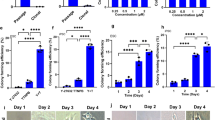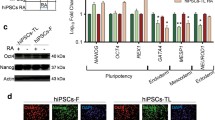Abstract
Menin, a ubiquitously expressed protein, is the product of the multiple endocrine neoplasia type I (Men1) gene, mutations of which cause tumors primarily of the parathyroid, endocrine pancreas, and anterior pituitary. Menin-null mice display early embryonic lethality, and thus imply a critical role for menin in early development. In this study, using the P19 embryonic carcinoma stem cells, we studied menin’s role in cell differentiation. Menin expression is induced in P19 cell aggregates by retinoic acid (RA). Menin over-expressing stable clones proliferated in a significantly reduced rate compared to the empty vector harboring cells. RA induced cell death in aggregated menin over-expressing cells. However, in the absence of RA, specific populations of the aggregated menin over-expressing cells displayed the characteristic of an endodermal phenotype by the acquisition of cytokeratin Endo A expression (TROMA-1), a marker for the primitive endoderm, with a concomitant loss of the stem cell marker SSEA-1. Menin’s ability to induce endodermal differentiation in specific populations of the aggregated cells in the absence of RA implied that menin could substitute RA by inducing a set of target genes that are RA responsive. Menin over-expressing cells upon aggregation showed a robust expression of RA receptors (RAR), RARα, β, and γ relative to the empty vector-harboring cells. Moreover, endodermal differentiation was inhibited by the pan-RAR antagonist Ro41-5253, suggesting that menin could induce endodermal differentiation of uncommitted cells by functionally modulating the RARs.




Similar content being viewed by others
References
Chandrasekharappa SC, Guru SC, Manickam P, Olufemi SE, Collins FS, Emmert-Buck MR, Debelenko LV, Zhuang Z, Lubensky IA, Liotta LA, Crabtree JS, Wang Y, Roe BA, Weisemann J, Boguski MS, Agarwal SK, Kester MB, Kim YS, Heppner C, Dong Q, Spiegel AM, Burns AL, Marx SJ (1997) Positional cloning of the gene for multiple endocrine neoplasia-type 1. Science 276:404–407
Guru SC, Agarwal SK, Manickam P, Olufemi SE, Crabtree JS, Weisemann JM, Kester MB, Kim YS, Wang Y, Emmert-Buck MR, Liotta LA, Spiegel AM, Boguski MS, Roe BA, Collins FS, Marx SJ, Burns L, Chandrasekharappa SC (1997) A transcript map for the 2.8-Mb region containing the multiple endocrine neoplasia type 1 locus. Genome Res 7:725–735
Guru SC, Crabtree JS, Brown KD, Dunn KJ, Manickam P, Prasad NB, Wangsa D, Burns AL, Spiegel AM, Marx SJ, Pavan WJ, Collins FS, Chandrasekharappa SC (1999) Isolation, genomic organization, and expression analysis of Men1, the murine homolog of the MEN1 gene. Mamm Genome 10:592–596
Maruyama K, Tsukada T, Hosono T, Ohkura N, Kishi M, Honda M, Nara-Ashizawa N, Nagasaki K, Yamaguchi K (1999) Structure and distribution of rat menin mRNA. Mol Cell Endocrinol 156:25–33
Wautot V, Khodaei S, Frappart L, Buisson N, Baro E, Lenoir GM, Calender A, Zhang CX, Weber G (2000) Expression analysis of endogenous menin, the product of the multiple endocrine neoplasia type 1 gene, in cell lines and human tissues. Int J Cancer 85:877–881
Agarwal SK, Guru SC, Heppner C, Erdos MR, Collins RM, Park SY, Saggar S, Chandrasekharappa SC, Collins FS, Spiegel AM, Marx SJ, Burns AL (1999) Menin interacts with the AP1 transcription factor JunD and represses JunD-activated transcription. Cell 96:143–152
Agarwal SK, Novotny EA, Crabtree JS, Weitzman JB, Yaniv M, Burns AL, Chandrasekharappa SC, Collins FS, Spiegel AM, Marx SJ (2003) Transcription factor JunD, deprived of menin, switches from growth suppressor to growth promoter. Proc Natl Acad Sci USA 100:10770–10775
Bertolino P, Radovanovic I, Casse H, Aguzzi A, Wang ZQ, Zhang CX (2003) Genetic ablation of the tumor suppressor menin causes lethality at mid-gestation with defects in multiple organs. Mech Dev 120:549–560
Dreijerink KM, Varier RA, van Beekum O, Jeninga EH, Hoppener JW, Lips CJ, Kummer JA, Kalkhoven E, Timmers HT (2009) The multiple endocrine neoplasia type 1 (MEN1) tumor suppressor regulates peroxisome proliferator-activated receptor gamma-dependent adipocyte differentiation. Mol Cell Biol 29:5060–5069
Novotny E, Compton S, Liu PP, Collins FS, Chandrasekharappa SC (2009) In vitro hematopoietic differentiation of mouse embryonic stem cells requires the tumor suppressor menin and is mediated by Hoxa9. Mech Dev 126:517–522. doi:10.1016/j.mod.2009.04.001
Lemmens IH, Forsberg L, Pannett AA, Meyen E, Piehl F, Turner JJ, Van de Ven WJ, Thakker RV, Larsson C, Kas K (2001) Menin interacts directly with the homeobox-containing protein Pem. Biochem Biophys Res Commun 286:426–431
Hipkaeo W, Sakulsak N, Wakayama T, Yamamoto M, Nakaya MA, Keattikunpairoj S, Kurobo M, Iseki S (2008) Coexpression of menin and JunD during the duct cell differentiation in mouse submandibular gland. Tohoku J Exp Med 214:231–245
Sowa H, Kaji H, Canaff L, Hendy GN, Tsukamoto T, Yamaguchi T, Miyazono K, Sugimoto T, Chihara K (2003) Inactivation of menin, the product of the multiple endocrine neoplasia type 1 gene, inhibits the commitment of multipotential mesenchymal stem cells into the osteoblast lineage. J Biol Chem 278:21058–21069
Sowa H, Kaji H, Hendy GN, Canaff L, Komori T, Sugimoto T, Chihara K (2004) Menin is required for bone morphogenetic protein 2- and transforming growth factor beta-regulated osteoblastic differentiation through interaction with Smads and Runx2. J Biol Chem 279:40267–40275
Naito J, Kaji H, Sowa H, Hendy GN, Sugimoto T, Chihara K (2005) Menin suppresses osteoblast differentiation by antagonizing the AP-1 factor, JunD. J Biol Chem 280:4785–4791
Aziz A, Miyake T, Engleka KA, Epstein JA, McDermott JC (2009) Menin expression modulates mesenchymal cell commitment to the myogenic and osteogenic lineages. Dev Biol 332:116–130
Hughes CM, Rozenblatt-Rosen O, Milne TA, Copeland TD, Levine SS, Lee JC, Hayes DN, Shanmugam KS, Bhattacharjee A, Biondi CA, Kay GF, Hayward NK, Hess JL, Meyerson M (2004) Menin associates with a trithorax family histone methyltransferase complex and with the hoxc8 locus. Mol Cell 13:587–597
Yokoyama A, Wang Z, Wysocka J, Sanyal M, Aufiero DJ, Kitabayashi I, Herr W, Cleary ML (2004) Leukemia proto-oncoprotein MLL forms a SET1-like histone methyltransferase complex with menin to regulate Hox gene expression. Mol Cell Biol 24:5639–5649. doi:24/13/5639[pii]
Chen YX, Yan J, Keeshan K, Tubbs AT, Wang H, Silva A, Brown EJ, Hess JL, Pear WS, Hua X (2006) The tumor suppressor menin regulates hematopoiesis and myeloid transformation by influencing Hox gene expression. Proc Natl Acad Sci USA 103:1018–1023
Maillard I, Chen YX, Friedman A, Yang Y, Tubbs AT, Shestova O, Pear WS, Hua X (2009) Menin regulates the function of hematopoietic stem cells and lymphoid progenitors. Blood 113:1661–1669
Maillard I, Hess JL (2009) The role of menin in hematopoiesis. Adv Exp Med Biol 668:51–57
Yokoyama A, Somervaille TC, Smith KS, Rozenblatt-Rosen O, Meyerson M, Cleary ML (2005) The menin tumor suppressor protein is an essential oncogenic cofactor for MLL-associated leukemogenesis. Cell 123:207–218
Crabtree JS, Scacheri PC, Ward JM, Garrett-Beal L, Emmert-Buck MR, Edgemon KA, Lorang D, Libutti SK, Chandrasekharappa SC, Marx SJ, Spiegel AM, Collins FS (2001) A mouse model of multiple endocrine neoplasia, type 1, develops multiple endocrine tumors. Proc Natl Acad Sci USA 98:1118–1123
McBurney MW, Jones-Villeneuve EM, Edwards MK, Anderson PJ (1982) Control of muscle and neuronal differentiation in a cultured embryonal carcinoma cell line. Nature 299:165–167
Martin GR (1980) Teratocarcinomas and mammalian embryogenesis. Science 209:768–776
Jones-Villeneuve EM, McBurney MW, Rogers KA, Kalnins VI (1982) Retinoic acid induces embryonal carcinoma cells to differentiate into neurons and glial cells. J Cell Biol 94:253–262
Bain G, Ray WJ, Yao M, Gottlieb DI (1994) From embryonal carcinoma cells to neurons: the P19 pathway. Bioessays 16:343–348
McBurney MW (1993) P19 embryonal carcinoma cells. Int J Dev Biol 37:135–140
Edwards MK, McBurney MW (1983) The concentration of retinoic acid determines the differentiated cell types formed by a teratocarcinoma cell line. Dev Biol 98:187–191
Rudnicki MA, Reuhl KR, McBurney MW (1989) Cell lines with developmental potential restricted to mesodermal lineages isolated from differentiating cultures of pluripotential P19 embryonal carcinoma cells. Development 107:361–372
Jho EH, Davis RJ, Malbon CC (1997) c-Jun amino-terminal kinase is regulated by Galpha12/Galpha13 and obligate for differentiation of P19 embryonal carcinoma cells by retinoic acid. J Biol Chem 272:24468–24474
Jho EH, Malbon CC (1997) Galpha12 and Galpha13 mediate differentiation of P19 mouse embryonal carcinoma cells in response to retinoic acid. J Biol Chem 272:24461–24467
Kanungo J, Potapova I, Malbon CC, Wang H (2000) MEKK4 mediates differentiation in response to retinoic acid via activation of c-Jun N-terminal kinase in rat embryonal carcinoma P19 cells. J Biol Chem 275:24032–24039
Wang HY, Kanungo J, Malbon CC (2002) Expression of Galpha 13 (Q226L) induces P19 stem cells to primitive endoderm via MEKK1, 2, or 4. J Biol Chem 277:3530–3536
Kashef K, Xu H, Reddy EP, Dhanasekaran DN (2006) Endodermal differentiation of murine embryonic carcinoma cells by retinoic acid requires JLP, a JNK-scaffolding protein. J Cell Biochem 98:715–722
Guru SC, Goldsmith PK, Burns AL, Marx SJ, Spiegel AM, Collins FS, Chandrasekharappa SC (1998) Menin, the product of the MEN1 gene, is a nuclear protein. Proc Natl Acad Sci USA 95:1630–1634
Kanungo J, Pratt SJ, Marie H, Longmore GD (2000) Ajuba, a cytosolic LIM protein, shuttles into the nucleus and affects embryonal cell proliferation and fate decisions. Mol Biol Cell 11:3299–3313
Bain G, Gottlieb DI (1994) Expression of retinoid X receptors in P19 embryonal carcinoma cells and embryonic stem cells. Biochem Biophys Res Commun 200:1252–1256
Skerjanc IS, Petropoulos H, Ridgeway AG, Wilton S (1998) Myocyte enhancer factor 2C and Nkx2–5 up-regulate each other’s expression and initiate cardiomyogenesis in P19 cells. J Biol Chem 273:34904–34910
Kanungo J, Wang HY, Malbon CC (2004) Ku80 is required but not sufficient for Galpha13-mediated endodermal differentiation in P19 embryonic carcinoma cells. Biochem Biophys Res Commun 323:293–298
Budhu AS, Noy N (2002) Direct channeling of retinoic acid between cellular retinoic acid-binding protein II and retinoic acid receptor sensitizes mammary carcinoma cells to retinoic acid-induced growth arrest. Mol Cell Biol 22:2632–2641
Pratt MA, Crippen CA, Menard M (2000) Spontaneous retinoic acid receptor beta 2 expression during mesoderm differentiation of P19 murine embryonal carcinoma cells. Differentiation 65:271–279
Boudjelal M, Taneja R, Matsubara S, Bouillet P, Dolle P, Chambon P (1997) Overexpression of Stra13, a novel retinoic acid-inducible gene of the basic helix-loop-helix family, inhibits mesodermal and promotes neuronal differentiation of P19 cells. Genes Dev 11:2052–2065
Hamada-Kanazawa M, Ishikawa K, Nomoto K, Uozumi T, Kawai Y, Narahara M, Miyake M (2004) Sox6 overexpression causes cellular aggregation and the neuronal differentiation of P19 embryonic carcinoma cells in the absence of retinoic acid. FEBS Lett 560:192–198
Kim S, Yoon YS, Kim JW, Jung M, Kim SU, Lee YD, Suh-Kim H (2004) Neurogenin1 is sufficient to induce neuronal differentiation of embryonal carcinoma P19 cells in the absence of retinoic acid. Cell Mol Neurobiol 24:343–356
Grepin C, Nemer G, Nemer M (1997) Enhanced cardiogenesis in embryonic stem cells overexpressing the GATA-4 transcription factor. Development 124:2387–2395
Skerjanc IS, Slack RS, McBurney MW (1994) Cellular aggregation enhances MyoD-directed skeletal myogenesis in embryonal carcinoma cells. Mol Cell Biol 14:8451–8459
Petropoulos H, Skerjanc IS (2002) Beta-catenin is essential and sufficient for skeletal myogenesis in P19 cells. J Biol Chem 277:15393–15399
Acknowledgments
This study was supported by Intramural Research Program of the National Human Genome Research Institute, National Institutes of Health, USA.
Author information
Authors and Affiliations
Corresponding authors
Rights and permissions
About this article
Cite this article
Kanungo, J., Chandrasekharappa, S.C. Menin induces endodermal differentiation in aggregated P19 stem cells by modulating the retinoic acid receptors. Mol Cell Biochem 359, 95–104 (2012). https://doi.org/10.1007/s11010-011-1003-2
Received:
Accepted:
Published:
Issue Date:
DOI: https://doi.org/10.1007/s11010-011-1003-2




